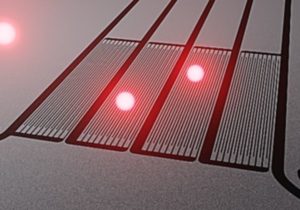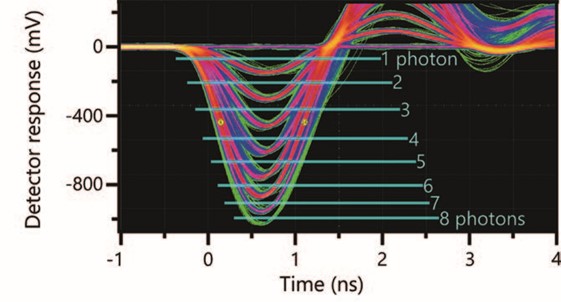State of the art in single-photon detection
Detecting single photons is hard. Not because they are strange wonders of quantum mechanics, but because there are simply too many of them. One has a similar problem counting the number of drops of water in the ocean.
It is relatively simple to turn a single particle of light into a machine-readable signal. Photomultiplier tubes (PMTs) and single-photon avalanche diodes (SPADs) can rapidly turn a single photon into many electrons, much like the clicks of a Geiger-Mueller tube detecting particles of ionizing radiation. The state of the single-photon detection art, however, lies with superconducting nanowire single-photon detectors (SNSPDs).

SNSPDs work by holding a single meandering line of superconducting material close to its superconducting threshold. A single incident photon will rapidly create a localized hotspot, and the transition from the superconducting to resistive state gives an incredibly sharp and measurable electronic pulse. This technology provides near-ideally high detection efficiency, super-precise timing and ultra-low noise, allowing researchers to see ever-smaller gaps in space and time, and making previously impossible photonic applications possible.
Parallel-Pixel SNSPDs: Advancements in Single-Photon Detection
Standard SNSPD designs can only detect the presence or absence of photons, and their performance is limited by the photon pile-up effect, often limiting their performance to detection rates of tens of MHz at best. An innovative solution is found in a parallel-pixel SNSPD design. In these devices (patent pending), an array of SNSPDs are connected in parallel to a single readout circuit. Here, single photons are much less likely to pile up at one pixel, with recovery times—the time taken for the detector to exceed and stay above 50% of its maximum efficiency after a detection—comfortably below 10 ns.

In recent collaborations with IDQ, researchers at the University of Geneva were able to demonstrate single-photon detection rates in excess of 200 MHz with such a detector [1]. Better yet, this detector design can also discriminate the photon number state, up to n photons for an n-pixel SNSPD, as seen in further recent work [2]. All while benefitting from SNSPDs’ near-ideal detection efficiency, unparalleled timing precision, ultra-low noise, and broadband operation.
This high-performance and continually-improving technology promises to enable a plethora of photonic applications, from higher secret-key-rates in QKD systems as shown in a recent collaboration between IDQ and the University of Geneva [3], to enhanced-precision metrology for industrial manufacturing, to entirely new uses in the field of photonic quantum computing.
For more information, read our blog: Parallel-pixel SNSPDs for Ultrafast and Photon-Number-Resolved Detection.
[1] M. Perrenoud et al., Supercond. Sci. Technol. 34 (2021) 024002
[2] L. Stasi et al., arXiv 2207.14538 (2022)
[3] F. Grünenfelder et al., Nature Photonics (2023)
A previous version of this article was originally published in the Photonics Switzerland’s 2023 brochure.


